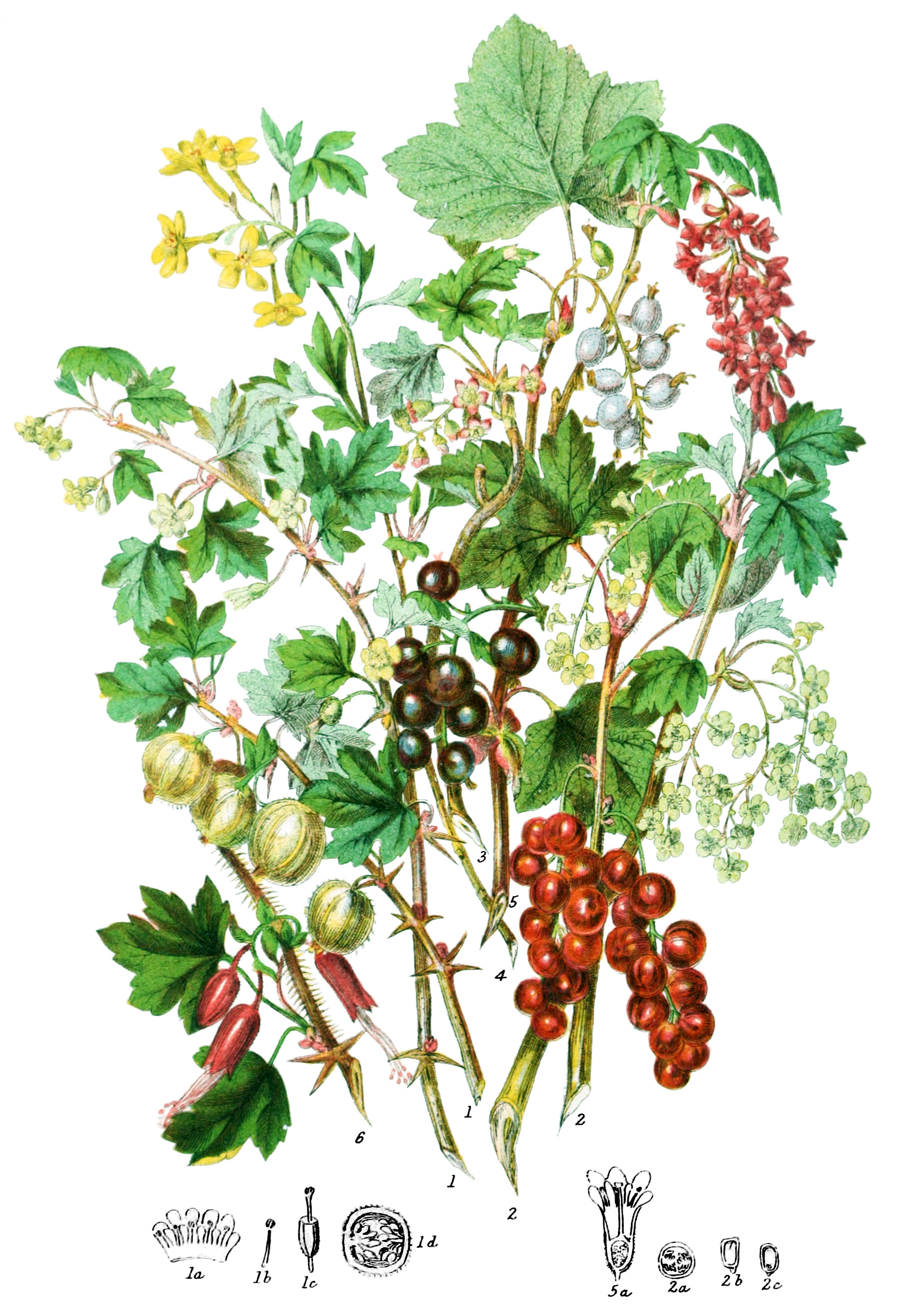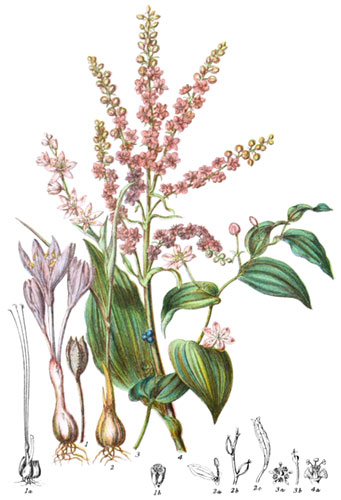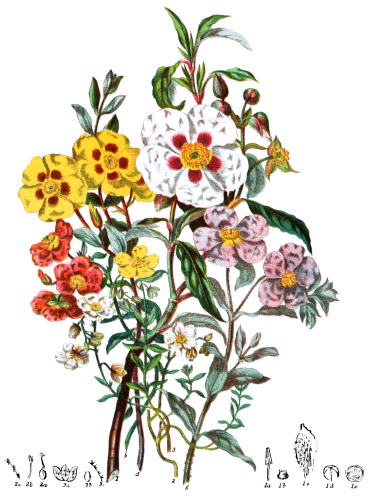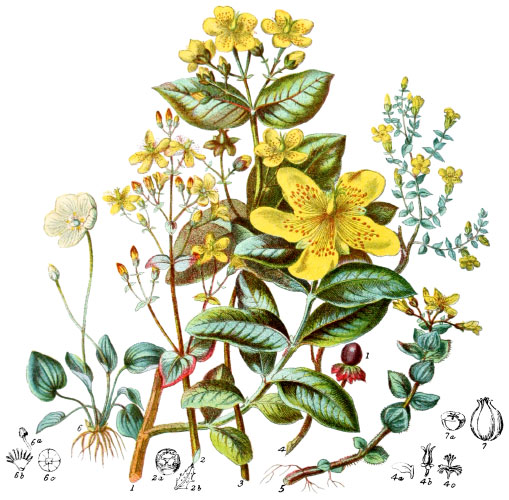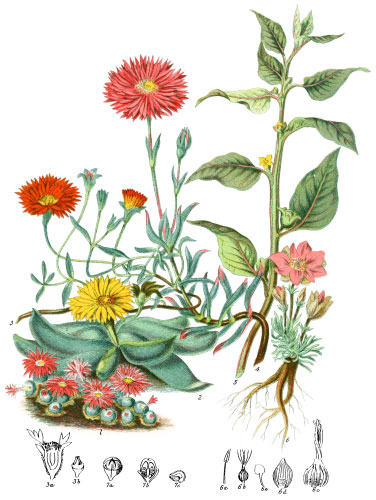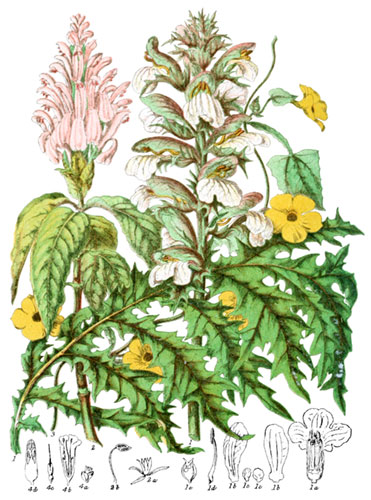Key characteristics
Shrubs, some of which are prickly; the leaves are alternate, lobed, plaited in the bud, often having a membranous fringed edge at the base of the leaf-stalks. The flowers grow in bunches, proceeding from the base of the leaf-stalks with bracts at the base; each flower-stalk has also a small bract. In some instances the flowers have an imperfect set of stamens and pistils: the calyx is above the ovary, four or five-lobed, often coloured, imbricated or somewhat valvate in the bud, remaining on the fruit. The petals are four, five, or wanting, minute, inserted on the throat of the clayx between the lobes. The stamens are four, or five, very short, placed between the petals; the anthers are small, two-celled, and in general burst internally and lengthwise by clefts. The ovary is one-celled, with two plates projecting from the edge; on these numerous ovules are placed on short stalks. The style is two, three, or four-cleft; the fruit is a berry crowned with the withered flower, one-celled, filled with pulp, in which the seeds are suspended by long threads. The seeds have a gelatinous covering adhering closely to the albumen, which is horny.
These shrubs have affinity with the Cactus tribe in the struture of the fruit; they have also some points of resemblance to the Saxifrage tribe.
Malic acid exists in a very large proportion of these fruits, but, blended with saccharine matter in the currant and gooseberry, produces refreshing cooling properties; vegetable jelly abounds in the fruit.
Select plants in this order
Not all plants listed are illustrated and not all plants illustrated are listed.
- Ribes is a genus of hardy shrubs, yielding useful fruit abundantly in the temperate climate of Britain; our native species have been much improved by cultivation, and are brought to the greatest perfection in this country, succeeding less well in the more northern or southern states of Europe; in the latter they are superseded by more lusciuos fruits.
- R. Grossularia (1) is found in the woods and hedges in some parts of Yorkshire and the south of Scotland; the branches are smooth between the leaves, but beneath each leaf-bud there are three strong prickles. The fruit is of two kinds—smooth and rough,—of various colours when cultivated; in the wild state it is yellowish green. Gooseberries are employed for many culinary purposes in an unripe state, being sufficiently palatable before the whole chemical process of perfecting the saccharine juice is completed; an excellent wine is made of them, rivalling the famed champagne of France; vinegar is also obtained from the juice, and a well-flavoured spirit may be distilled from the skins.
- R. rubrum (2) is occasionally met with in mountain woods, on the banks of rivers, in the north of England and south of Scotland; it grows also in the north of Germany, on the Jura and Lower Alps. The leaves have long stalks, and are fringed at the base; the fruit is in drooping clusters, alwasy smooth, red when ripe, extremely grateful and wholesome, and can be preserved with sugar for winter use.
- R. nigrum (3) grows in several counties of England in moist shady places; it is distinguished from other species by the aromatic glands of the leaves, flower, and fruit, and by the solitary berry on a separate stalk at the base of the cluster; the petals change occasionally into stamens. The fruit has a peculiar subacid property, which renders it valuable as a remedy in sore throats; in Siberia, wine is made from it, and a kind of tea is made with the leaves.
- R. sanguineum (5) was discovered, in 1787, in Nootka Sound, by Archibald Menzies, and afterwards found by him on his voyage with Vancouver, in 1792, on several parts of the mountain tracts of the north-west coast of North America, between lat. 38° and 52°. The natural situations appear to be confined to rocky places within the influence of the sea-breeze; sometimes it grows in shady parts of a shingly shore. It has of late years become acclimatized in our gardens; at first one or two berries only ripened on a cluster, now several come to perfection, although they are of a slenderer, more oval shape than they were described to be by the first discoverers.
- R. divaricatum bears a pleasant fruit as large as a gooseberry, in the vicinity of Indian villages on the coast.
- R. setosum is a very bristly species on the Missouri river.
- R. aureum (4) is smooth, with a tubular and coloured calyx.
- R. punctatum grows near Valparaiso in Chili.
- R. speciosum (6) is remarkable for the highly developed calyx. The elevated range of the Himalaya affords favourable localities for these shrubs; R. glacialis, nearly allied to our R. petræum, has been found on Gossianthan, Choor, and Manma, at elevations of 8000 and 10,000 feet: R. acuminatum is also seen there, as well as eastwards in Nepal; the read and black currants were found amongst the highest shrubs in the Choor mountain, at 11,800 feet.
- R. Himalensis flourishes near the almost inaccessible sources of the Ganges; these Asiatic species secrete acid and jelly, but less saccharine matter than those of European growth.
- Polyosma is a genus closely allied to the Ribes, belonging to the South Sea Islands, having an enlarged calyx and extremely fragrant flowers.
Locations
This Tribe inhabits the woods and mountains of the Temperate countries of Europe, Asia, and America; the greatest number of species exist in North America. In the Troics of Asia and in the South Sea Isles the Tribe is represented by Polyosma.
Legend
- Ribes Grossularia, Common Gooseberry. Britain.
- Flower, open.
- Stamen.
- Ovary.
- Section of Fruit.
- Ribes rubrum, Red Currant. Britain.
- Section of Ovary.
- Seed, magnified.
- Section, m.
- Ribes nigrum, Black Currant. Britain.
- Ribes aureum, Yellow-flowered Ribes. Missouri.
- Ribes sanguineum, Red-flowered Currant. N. America.
- Section of Flower.
- Ribes speciosum. Showy-flowered Ribes. California.
Explore more
Posters
Decorate your walls with colorful detailed posters based on Elizabeth Twining’s beautiful two-volume set from 1868.
Puzzles
Challenge yourself or someone else to assemble a puzzle of all 160 botanical illustrations.
